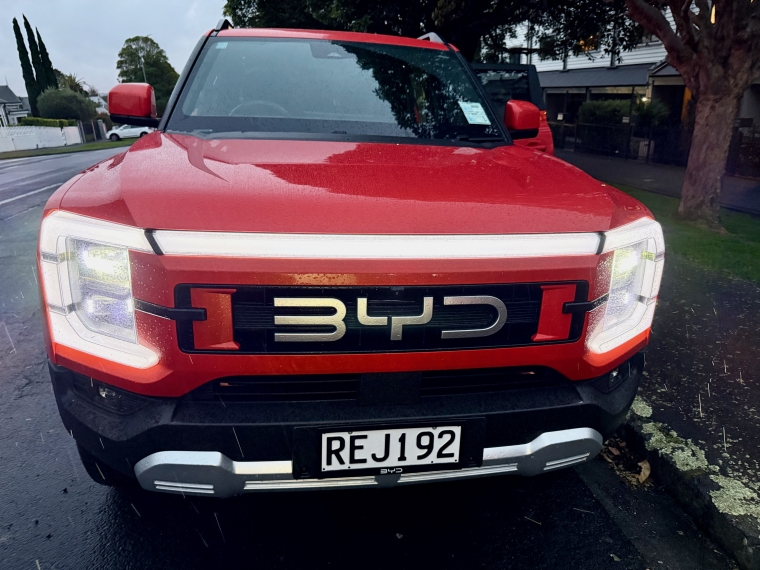
Few things excite New Zealand motorists as much as a new ute on the market, particularly if it’s an unusual, plug-in hybrid electric vehicle (PHEV) like the BYD Shark 6.
Launched last year in Aotearoa, the Shark 6 is still a novelty that people are very curious about. If you drive around in one like I did for just under a week, prepare for the experience by reading up on the vehicle specifications because people will come up and ask you about the Shark 6.
Like, it’s dimensions because the Shark 6 is big at 5457 millimetres (nearly 5.5 metres) long, and 1971 mm wide. It’s also 1925 mm tall so you quickly learn to appreciate the high-resolution cameras, one of which has a bird’s eye view of the world. Parking in town would be nerve-wracking without them.
The Shark 6 also weighs 2710 kg before passengers and cargo.
Quite a heavy vehicle then, but the EV powertrain with two motors, a 170 kilowatt / 310 Newton-metres of torque at the front, and a 150 kW / 340 Nm unit at the rear means you don’t notice the weight much; plus there’s the 1.5 litre turbo petrol engine with 135 kW / 260 Nm as well.
Combining the three motors, you get 321 kW and 650 Nm. Those are big numbers for a ute and the Shark 6 is effortlessly quick. A few 0-100 km/h runs in Sports mode suggest that the 5.7 second sprint is possible.
There’s no turbo lag in the Shark 6, just instant EV go, which is great when you attempt those very dangerous manoeuvres on Kiwi motorways, namely merging and lane changing while other drivers speed up to close the gap.
Our review car was finished in a new very visible orange colour, and the design of the Shark 6 is bold and brash. Square even, and I quite liked it, with the King Charles ears sized wing mirrors and LED headlights.
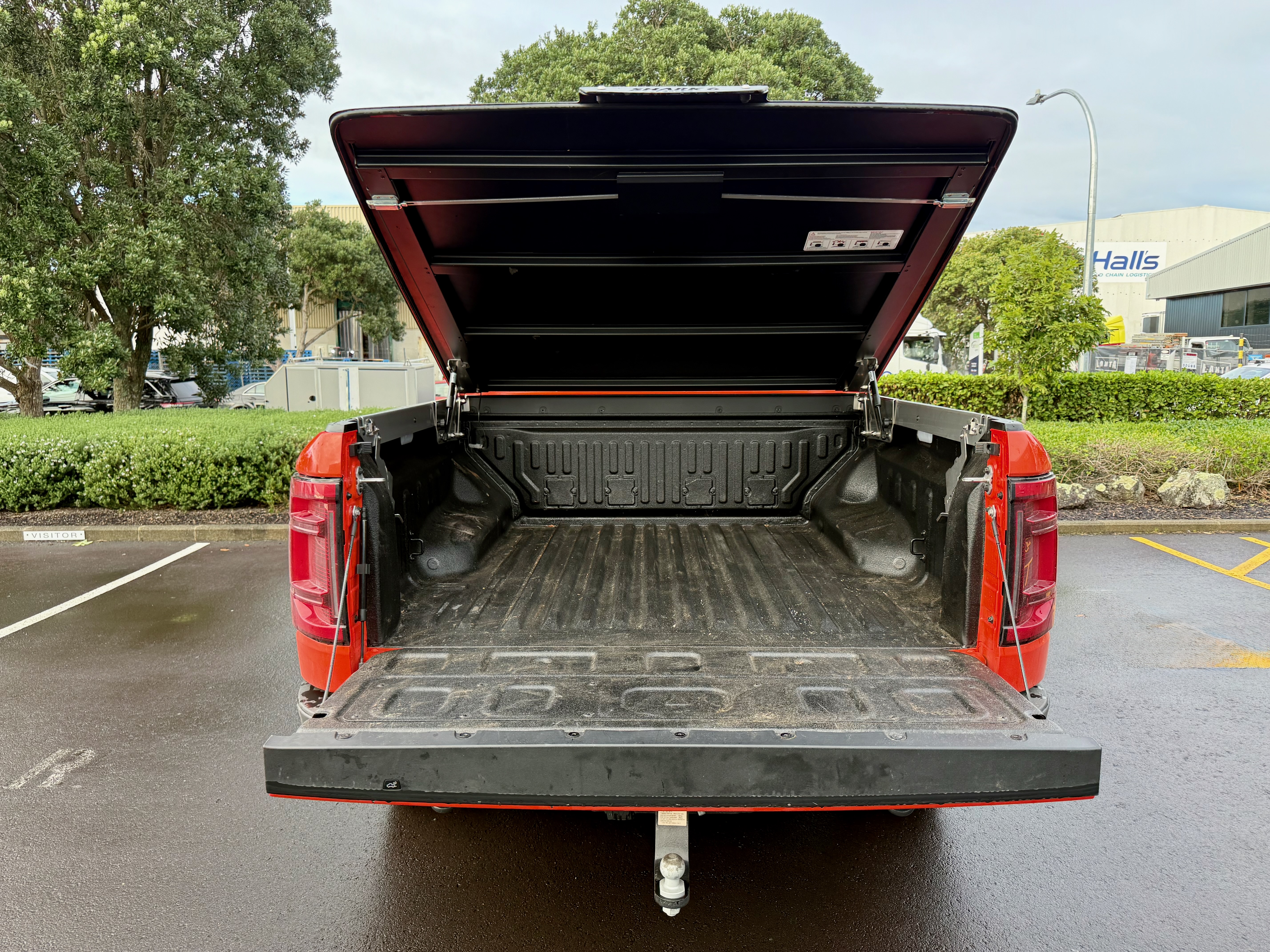
A lockable metal tonneau cover from Mac that’s weatherproof and able to carry 200 kg on the lid was an extra for the review Shark 6. It costs $4000 if bought from a BYD dealer and the orange paint added another $1250 to the Shark 6’s $69,990 recommended pricing.
Lux interior
Inside, the Shark 6 isn’t very ute like. All the materials feel very premium, soft to the touch and very nicely designed. There are zero squeaks and rattles even when going over deep winter rain created potholes.
The power heated/vented front seats are big and comfortable for long drives (we did just over a thousand km in the Shark 6). Everyone including backseat passengers have plenty of space, legroom, USB-C ports for device charging, and air conditioning in the double-cab Shark 6.
The rear seats are comfy and not back-breakingly upright like in some other utes. Life’s good in them.
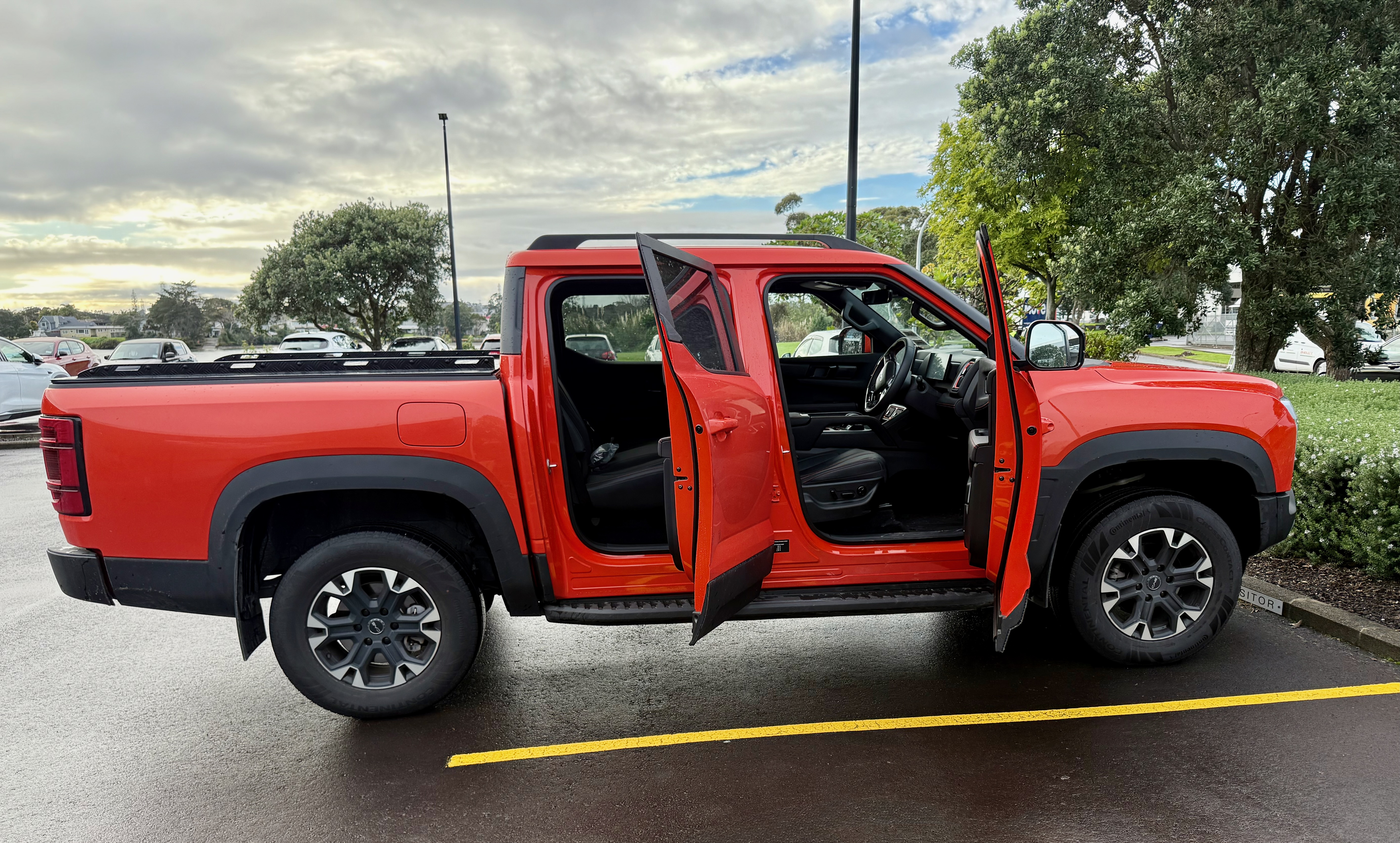
Ergonomically, the controls in the cabin are mostly fine with steering wheel buttons for the well functioning radar cruise control, power train and terrain modes (mud, sand, snow and mountain).
A big infotainment touch screen measuring 15.6 inches is the centrepiece at the front, and the driver gets a 10.25-inch variant behind the wheel, plus a heads up display (HUD) with great visibility even with the sun set low.
The touchscreen is nice and sharp, providing all the information you might need, and has a responsive interface. Plus it can do that BYD party trick of rotating into portrait mode which would be way more useful if Apple CarPlay and Android Auto worked with the screen upright, but they don’t.
More buttons instead of touch screen elements would be an improvement because they just work better and are easier to use. The screen also gets fingermarked quickly as you prod it and swipe to change settings.
A way to permanently switch off some of the alerts in the car would be welcome. Like the Child Presence Detection (CDP) feature that loudly went off without fail for my 185 cm 14-year-old, and for myself, with the Shark 6 parked and turned off while charging.
Having to poke the screen on each startup to disable that, and the lane keeping bongs, gets old and tired fast.
Doesn’t drive like a ute
“Ute like” doesn’t describe how the Shark 6 drives either. As noted earlier, it’s really quick and responsive, and the handling is pretty good without much lean in the corners. BYD couldn't completely hide the size and weight though, and the Shark 6 starts to understeer a little around the bends if you forget its dimensions.
The Shark 6 is wonderfully quiet inside though, making it a great long distance vehicle. You can tell when the engine kicks in, but only just. I can’t tell you how much this matters on regular, longer drives.
There’s a small amount of suspension thumpiness when unladen; some of that might have been a bit more noticeable than normal as the dealership had aired up the tyres for a full load and I didn’t bother to drop down the pressure.
Speaking of tyres, they are big 265/65 on R18 wheels, with plenty of sidewall which is excellent - and a full-size spare is included. I regularly see utes with huge wheels and skinny tyres, thinking that their drivers are either missing the point of the vehicle type, or really enjoy scraping the rims and having punctures.
Overall, the Shark 6 is a pleasure to drive in a variety of conditions. We went through a massive rain storm that started upon leaving Auckland and continued throughout most of Northland. The Shark 6 didn’t skip a beat on that trip and confidently powered through the insane amounts of water.
Essentially, it’s a much more normal-car-like driving experience compared to a regular turbo diesel ute with a live, leaf-sprung rear axle (the Shark 6 has individual wheel suspension front and rear).
Although the Shark 6 is built as a heavy-duty ladder-frame chassis vehicle, its electrification means there are notable differences from traditional utes.
First, there’s no gearbox, just single-speed drive as in most other EVs.
Furthermore, the Shark 6 drives both axles which are not connected to each other. Traction control electronics and software decide how the four wheels are driven. There are no differential locks for the axles.
That powertrain setup requires electric power to be available at all times for the motors. The Shark 6 sets off in EV mode, fires up the engine (HEV mode) at over 70 km/h speed to charge and to drive the front axle (apparently).
It never lets the battery charge drop below 22 to 25 per cent, and you can hear the petrol engine quietly humming away in the background, revving up as it decides to top up the electric energy storage.
Northland being a huge mudpool, and the Shark 6 wearing road-biased Continental tyres meant that we took it easy venturing off the tarmac, with just a few logging road sidequests; which the Shark 6 handled just fine with 230 mm ground clearance.
Ideally, we would’ve towed something close to the 2500 kg max load to see how the Shark 6 handled and braked; or bumped around on country roads with 800 kg payload in the tray, giving the car a proper mud-baptism at the same time, like so:
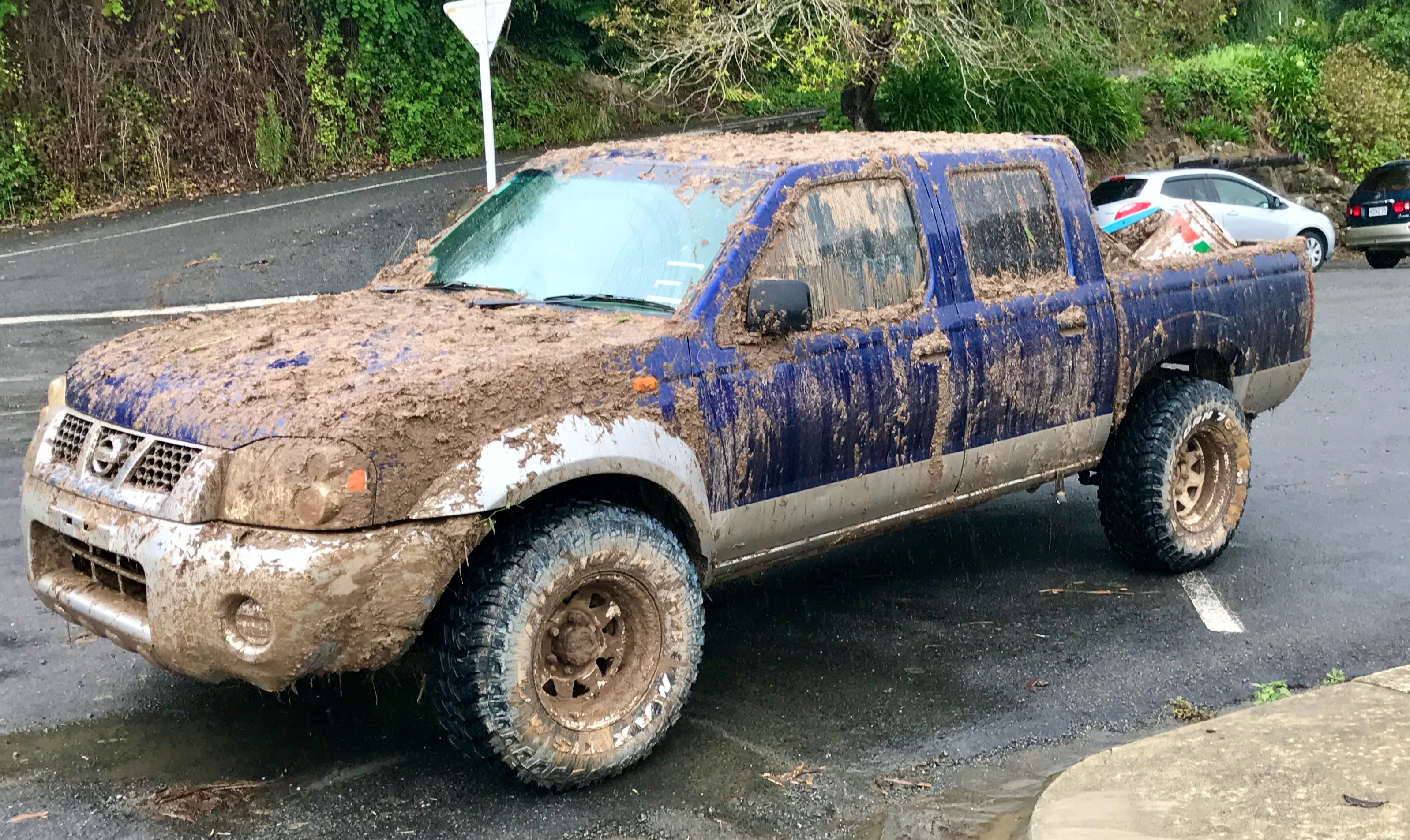
That would require all-terrain tyres on the truck, and being accompanied by a recovery vehicle. As it is, the Shark 6 will probably handle the vast majority of anyone’s moderate off-roading needs.
BYD has a Shark 6 related platform, the one used in the Chinese car maker’s Fang Cheng Bao (Formula Leopard) 5 off-roader, which has front and rear diff locks, and a centre one too (how?). That and a bigger two-litre engine are rumoured to arrive for the Shark ute next year, but we’ll see if it does and how much cost it’ll add.
Plenty of two-wheel drive utes (and SUVs) are sold in NZ after all, and they seem to handle soggy berms on the school run just fine. A surprising amount of people aren’t familiar with what diff locks are used for either.
Range and fuel consumption
As expected, how much fuel you use with the Shark 6 depends on how often you charge the just under 30 kWh battery. In pure EV mode, the Shark 6 is rated as having 100 kilometre range; this seems a bit optimistic.
Fully charged and filled up, it made 75 km hilly highway trips to and from Kerikeri using up 65 per cent of the battery capacity, and one per cent of the petrol, in Normal drive mode.
It worked out as 2.4 l/100 km of petrol use according to the onboard computer.
The range using both petrol (60 litre tank) and battery is said to be 800 km. I think there’s a chance of getting close to that, in Eco mode that dials down the car’s responses, the regenerative braking set to high (BYD doesn’t do one-pedal driving) and judicious use of EV only mode, like in cities. You can set the Shark 6 to save the battery state-of-charge for when you arrive, incidentally.
With a fully charged battery, and 60 litres of 91 octane onboard, we drove down to Auckland, taking 375 km to do so. The indicated range at the destination was 342 km, and a just under half-full petrol tank.
If your trips are short and covered by the battery range, the Shark 6 incurs low petrol costs. With the SOC down to 22-25 percent, the onboard computer reported 9.2 litres/100 km going up steep hills with a light load. More than the 7.9 l/100 km official figure, but acceptable given the size of the vehicle.
Unfortunately, I didn’t have the car long enough to work out how to “hypermile” with the Shark 6. One acquaintance specialises in that kind of driving with hybrid vehicles, but I suspect most people will just let the car do its thing and manage the transition from pure EV to HEV, in either Eco mode, or Normal mode which the Shark 6 defaults to at each startup.
As for charging the battery, install a 7 kW AC unit at home for the Shark 6 and be done with it. The car will charge over standard 230 Volt power point as well (and there’s a Type 2 charger included with the Shark 6); I got around 1.6 kW that way so yeah, that 7 kW AC thing is good to have.
There’s a strange bug in the Shark 6 which saw the low-power 1.6 kW or so AC charging stop after a few minutes, unless you leave the key in the unlocked car. This didn’t happen with DC charging, and I hope BYD fixes it.
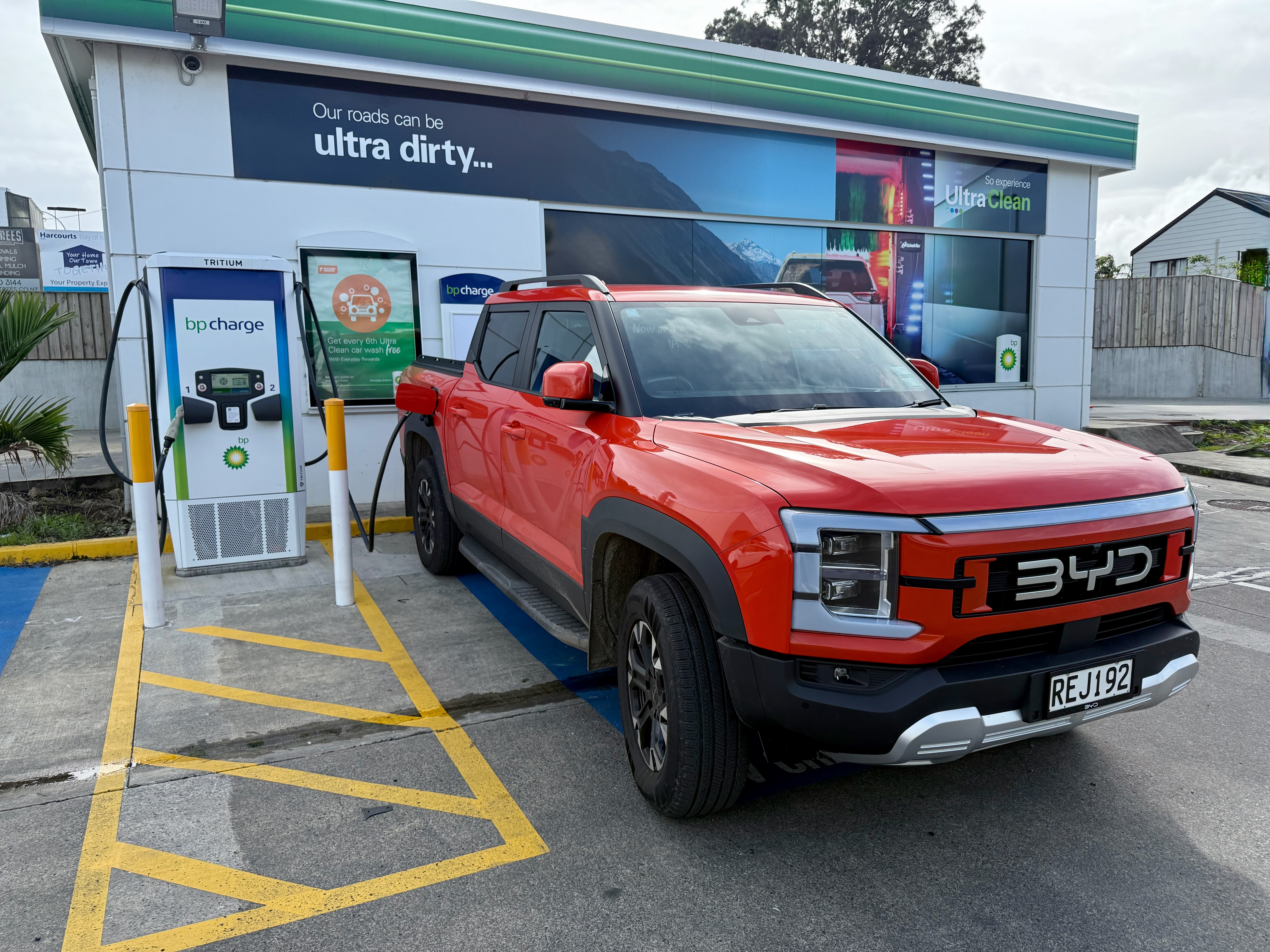
For fast DC charging, aim to use a station quicker than 50 kW. I topped up at BP’s 75 kW Tritium brand charger, and even though the Shark 6 is rated at 55 kW speed, I got almost 60 kW. The Shark 6 has BYD’s blade battery, and charging doesn’t slow down until you get close to 90 per cent full when it reduces to ~18 kW, and then to 7 kW for the very last bit. I have noticed that different make EV chargers affect that rate, so this could be Tritium specific.
A pleasingly different take on utes
A not to be overlooked plus is how electric power adds to the utility (sorry) of utes. The Shark 6 has a vehicle to load (V2L) system that can output at total of 6 kW, with plugs in the tray, a supplied adapter for the charging connector, and in the cabin.
You can run electric tools off the V2L, water blasters and charge batteries, which is great for contractors. Yes, it’s fine for making flat whites too.
Meanwhile, warranty for the Shark 6 is six years, or 150,000 km (whichever comes first); the battery is covered by eight years of warranty, or 160,000 km. BYD also has eight years of roadside assistance.
It’s easy to see why the competitively priced Shark 6 has shot up the sales charts in New Zealand, being comfortable, capable, and positively luxurious for the money.
The Shark 6 does all that with relatively modest energy consumption as well, but it’s not going to magic away petrol use. Factor in charging the car’s battery as often as possible.
4 Comments
If this is what China can do in a decade, imagine what is coming. This car doesn't suit all applications for ute owners, but for others it will be incredible.
While this is an impressive looking vehicle, in a forum such as interest.co.nz it would be interesting to have some discussion on the economic aspects involved.
Financially, how does it stack up against a 2022 Ford Ranger with 80000Km on the clock etc. Etc.
Fair comment but too early I suggest.
I must admit I'm interested. BYD are fast garnering a robust reputation for quality and technology. I drive a Ford Ranger (2015, had it since new) and like the engine. With an engineering back ground I'm a little wary of the bi-turbo, two turbo chargers in tandem, arrangement when towing a big load which I do occasionally. My current options tend to lean towards the Ranger V6 options, but this hybrid may well do the job when i need it.
If you watch 4wd/24-7 on YT they towed with the Shark and it was a disaster, that would be it's Achilles. I'm surprised your 2l bi-turbo is still going after 10y, the wet belts have a terrible reputation. Sound like you need an F truck or Silverado!

We welcome your comments below. If you are not already registered, please register to comment.
Remember we welcome robust, respectful and insightful debate. We don't welcome abusive or defamatory comments and will de-register those repeatedly making such comments. Our current comment policy is here.